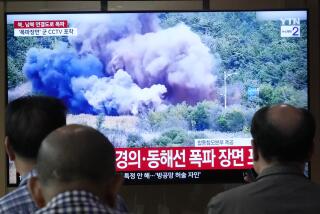N. Korea Unilaterally Shifts Maritime Border : Asia: Decision enrages Seoul, but analysts are unsure whether Pyongyang will match its rhetoric with action.
- Share via
SEOUL — North Korea’s military ratcheted up tension in the region Thursday by declaring that it has unilaterally redrawn the decades-old de facto maritime border with South Korea and threatening to enforce the new line “by various means.”
The new demarcation would extend the demilitarized zone between the two Koreas southwest into the Yellow Sea, placing five islands controlled by South Korea within the North’s territory, the South Korean Defense Ministry said.
The move came just as the threat of a North Korean ballistic missile test appeared to be receding after the Communist government agreed to meet Tuesday with American officials in Berlin. Negotiators will discuss easing U.S. economic sanctions against North Korea in exchange for a moratorium on the regime’s missile program.
South Korean officials immediately termed the announced shift of the border “outrageous.” They vowed to defend the existing “northern limit line,” which was unilaterally imposed by the United Nations Command in 1953 at the end of the Korean War, until the two Koreas can negotiate a new boundary in ongoing talks under U.N. auspices.
The two sides have had six rounds of unsuccessful talks over the disputed waters since a naval battle erupted in the Yellow Sea in June, resulting in heavy North Korean losses.
“An eye for an eye, a tooth for a tooth,” said an unnamed South Korean Defense Ministry official quoted in the South’s hawkish Chosun Ilbo newspaper. “We will retaliate against any North Korean military movement.”
However, a U.S. official here said the practical effect of the North’s move depends on whether it sends warships to try to press its claim.
“It depends on what they actually do, not what they say,” said the official, who requested anonymity. “There’s a big difference between asserting things--especially on this peninsula--and trying to enforce things.”
Former U.S. Ambassador to South Korea Donald Gregg also cautioned against overreacting.
“This is just one of many issues that the North and South need to discuss if they’re really going to move toward reconciliation,” Gregg said in a telephone interview from New York, where he heads the Korea Foundation.
North Korea’s seemingly contradictory behavior--agreeing to negotiations and then immediately provoking fresh tensions--is “typical behavior by a totalitarian state,” tactics that were employed for years by the Soviet Union, China and other countries, Gregg said.
“They constantly negotiate at the brink,” he said.
South Korea commentators suggested two possible motives for the North Koreans’ action: to increase their leverage at the negotiating table in Berlin or to retaliate for their humiliating naval defeat in the Yellow Sea.
“North Korea needs an excuse to be angry,” said Chi Man Won, an independent South Korean military analyst. “So they will be very stern and strong about this issue and tension will develop, and then they will use that tension as an excuse to test-fire the missile.”
U.S. intelligence reports indicate that North Korea’s new Taepodong 2 missile has a range of 4,000 miles, putting it in reach of Alaska.
North Korea has never formally accepted the U.N.’s limitation line, but it did not challenge it for decades. Then in June, during the prime season for a particularly lucrative species of crab, North Korean boats made repeated forays over the line and South Korean patrol boats repulsed them.
The skirmishes escalated into a naval battle on June 15, and North Korea’s antiquated flotilla was badly overmatched. A North Korean torpedo boat was sunk and 30 crew members reportedly were killed. At least five other North Korean vessels were badly damaged, while only a few South Korean sailors suffered minor injuries.
The clash “was a bonanza of intelligence on the North Korean military,” a well-placed South Korean source said last month. South Korea concluded that the skirmish was unplanned and showed that the morale and materiel of the North Korean forces were in “a pathetic state,” the source said.
In a statement by Kim Young Choon of the North Korean army’s general staff, broadcast by the official media, North Korea said it was declaring the Northern Limit Line invalid after its demand that the line be moved southward was ignored in the U.N. negotiations.
Some of the area within the new line lies within the 12-mile territorial waters claimed by North Korea. The five islands controlled by South Korea had a total of 11,500 inhabitants as of 1993, according to the Encyclopedia of Korea. South Korea has military bases on the two largest islands, Paek Ryong and Young Pyong, and is believed to have missiles on at least one island.
There was no immediate word from South Korean President Kim Dae Jung. During the naval confrontation in June, he ordered a vigorous defense of South Korea’s buffer zone. However, as soon as the battle was over, he announced that his policy of seeking to engage the North in the peace process would be unaffected. Kim reiterated that policy in an article published Monday in The Times and other newspapers.
*
Chi Jung Nam in The Times’ Seoul Bureau contributed to this report.
(BEGIN TEXT OF INFOBOX / INFOGRAPHIC)
N. Korea ‘Shifts’ Border
The North Korean military’s unilateral decision Thursday to redraw the maritime boundary it shares with South Korea was roundly rejected by Seoul. If allowed to stand, the change would place five strategic islands now controlled by the South in the Communist regime’s territory. South Korea has military bases on two islands.
Source: The Chosun Ilbo Korean newspaper
More to Read
Sign up for Essential California
The most important California stories and recommendations in your inbox every morning.
You may occasionally receive promotional content from the Los Angeles Times.










